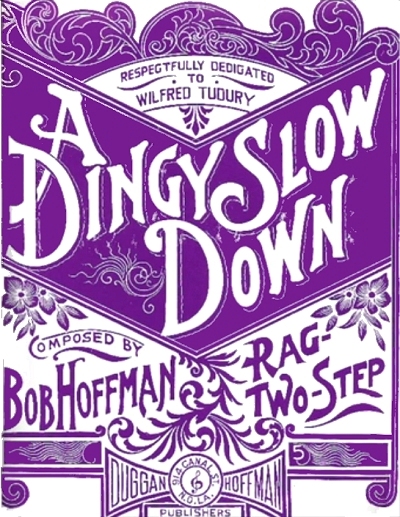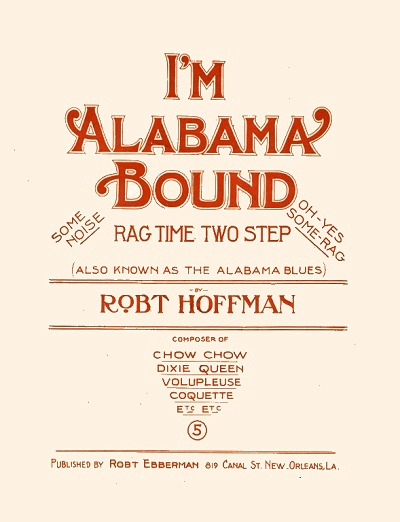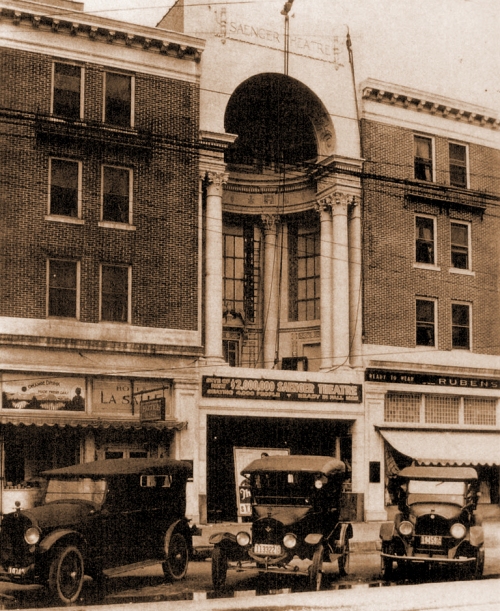While New Orleans was known to have produced a number of talented black musicians who helped to create ragtime and early jazz, among them being "Jelly Roll" Morton and Joseph "King" Oliver, at least one native white composer not only became known for at least one of his interpretations of an old Southern folk song, but unlike so many others, stayed in the Crescent City for pretty much his entire life. George Robert Hoffman [Jr.?] (in later years he reversed the first and middle name and went by Robert George) was reportedly born to George Robert Hoffman and Josephine Cotton. A marriage certificate from 1900 identifies his father as a G.R. Finlay, so Hoffman may have been the name of a stepfather, but the source for this is unclear. He had three younger siblings, including Annie (10/1882), Malcolm John (1/1/1887), and Beverly William (9/29/1889). The elder George Hoffman died in the mid-1890s. The only potential clue of his occupation was an 1893 New Orleans city directory indicating that he may have been a travel agent, possibly for a railroad.
He had three younger siblings, including Annie (10/1882), Malcolm John (1/1/1887), and Beverly William (9/29/1889). The elder George Hoffman died in the mid-1890s. The only potential clue of his occupation was an 1893 New Orleans city directory indicating that he may have been a travel agent, possibly for a railroad.
 He had three younger siblings, including Annie (10/1882), Malcolm John (1/1/1887), and Beverly William (9/29/1889). The elder George Hoffman died in the mid-1890s. The only potential clue of his occupation was an 1893 New Orleans city directory indicating that he may have been a travel agent, possibly for a railroad.
He had three younger siblings, including Annie (10/1882), Malcolm John (1/1/1887), and Beverly William (9/29/1889). The elder George Hoffman died in the mid-1890s. The only potential clue of his occupation was an 1893 New Orleans city directory indicating that he may have been a travel agent, possibly for a railroad.Growing up in the influences of the music of New Orleans, Robert had a yearning and the talent to be a musician. He studied piano and other facets of music in his youth, and eventually ended up working for a bicycle store in his teens. Eventually he would work for a music store. The 1900 census showed Robert living with his widowed mother and siblings in New Orleans, along with one servant. He was listed simply as a salesman. On June 11, Robert, still going by George R., was married to Elizabeth Clemence Shearman. his first published work also came in 1900. A Dingy Slowdown was a good example of what would become Robert's signature composition style, which compelled the performer to take a little more time to get through the piece, while conveying a lot of musical information in a laid back style. While not prolific, Hoffman proved to be somewhat versatile, issuing a waltz in 1902, followed by a rag and a novelette in 1903.
The 1904 city directory showed that Robert was employed by the Cable Company music store, who had also issued a couple of his works. There are indications that he was also a New Orleans representative for publisher Victor Kremer from Chicago, who also issued or re-issued a couple of Hoffman's pieces. Another work came out in 1906, the engaging rag Dixie Queen. By this time his first marriage had ended, but he would move on in 1907, marrying Mary Louise Setze on June 7 of that year. The 1907 New Orelans city directory showed Robert's occupation now as a musician, as he was performing in local vaudeville, and sometimes as an accompanist for others. Two more works were issued in 1908 by Kremer, including a reprinting of his earlier Fans and Glances. Voluptueuse was a slow waltz that may have been part of the formal dances of the New Orleans social life, calling on traditional musical genres as well as the new ones that were developing there. The somewhat more ethnic A Black Hand was issued by his local employer, the Cable Company.
Two more works were issued in 1908 by Kremer, including a reprinting of his earlier Fans and Glances. Voluptueuse was a slow waltz that may have been part of the formal dances of the New Orleans social life, calling on traditional musical genres as well as the new ones that were developing there. The somewhat more ethnic A Black Hand was issued by his local employer, the Cable Company.
 Two more works were issued in 1908 by Kremer, including a reprinting of his earlier Fans and Glances. Voluptueuse was a slow waltz that may have been part of the formal dances of the New Orleans social life, calling on traditional musical genres as well as the new ones that were developing there. The somewhat more ethnic A Black Hand was issued by his local employer, the Cable Company.
Two more works were issued in 1908 by Kremer, including a reprinting of his earlier Fans and Glances. Voluptueuse was a slow waltz that may have been part of the formal dances of the New Orleans social life, calling on traditional musical genres as well as the new ones that were developing there. The somewhat more ethnic A Black Hand was issued by his local employer, the Cable Company.Hoffman's most prolific year was 1909, which saw four works released. Among them was a celebration of New Orleans life, Mardi Gras; a fine waltz, Coquette; the nicely crafted and somewhat popular Chow Chow Rag; and the piece he would become most known for. I'm Alabama Bound (a.k.a. Alabama Blues, or at least the first section of the work, was not Hoffman's own, but was a re-arrangement of a known Southern folk tune that was first published by Robert Ebberman of the D.H. Holmes Department Store where Robert was now working. Indeed, that same year in Missouri, John "Blind" Boone's second ragtime medley, Strains from the Flat Branch, would include an almost identical snippet of the same piece with identical title for that portion of the medley. Robert's version caught on more quickly, and became a good seller, as well as popular recording piece. While not really a true blues, as the subtitle suggested, it did have some of the elements of Southern blues within, and would influence a few blues pieces in later years. Other titles for the tune included Elder Green's in Town, and the popular alternate, Don't You Leave Me Here, which Jelly Roll Morton claimed to have composed in 1905 in Mobile, Alabama. While the similarity between the Morton and Hoffman tunes is evident, it is not identical. There is enough available information to dismiss Morton's original authorship of the work, suggesting that both of them, along with Boone, more or less transcribed the earlier work. In late 1909 the property was transferred to The Music Shop on Canal Street which re-issued the piece, replacing the text cover with a stereotyped "coon" song illustration, followed by a vocal edition, with lyrics likely by the Music Shop's proprietor John J. Puderer, with whom he had written an earlier song.
The 1910 census taken in New Orleans showed Robert listed as a publisher of music, which means he either had a stake in a local firm, or was just stating "composer" in a different manner. He was clearly more of a performer. According to Dave Jasen and Gene Jones in That American Rag (2000), future jazz writer/research Roy Carew was a regular at Holmes, and remembered Hoffman as "a pleasnt, sociable man who demonstrated popular of all sorts in a 'smooth and relaxed' style." He also prefered playing from a chair instead of a bench, and reportedly played with the bottom side of his fingers rather than the tips, although that is hard to confirm, and may be an observation based on sight lines.
There would only be one more known work from his pen, the quirky Pussy Foot (not to be confused the Pussyfoot by James M. White which was published in 1916).
Starting in the early 1910s, Hoffman became a regular in New Orleans theaters as an accompanist, soloist, and the growing field of cinema pianist. Prior to the opening of the larger movie theaters, he worked the Plaza Theatre and other assorted venues. In 1913 or thereabouts, Robert was introduced to a young lady who had been working as a demonstrator in the sheet music department of a Woolworth five and dime in Memphis, Tennessee. Earlier in the year she was asked by a manager of the large New Orleans branch of the Kress department store to come and manage their music department, as well as work as a demonstrator. A mutual friend introduced her to Hoffman, who learned that she was trying to gain traction as a cinema performer. It was a coincidence that her name was similar to Mrs. Hoffman; Mary Louise Nadal. He took an interest in her career and they forged a friendship as Miss Nadal took some lessons from Robert.
 |
During this period, noting a growing trend in cinema music, Hoffman had also started taking organ lessons, and soon was able to command the large theater organs that were becoming staples at cinemas around the country. He concurrently passed some of his newly acquired skills on to Mary using an organ at a St. Charles Avenue church. When Hoffman learned of an opening at the Plaza Theater where he had also worked, he helped her to secure that job. Miss Nadal soon became quite successful as a cinema pianist and organist in rival New Orleans theaters. While listed as a musician in the New Orleans city directories of the early-to-mid-1910s, by 1918 Robert was consistently listed as an organist, and would continue this as his primary occupation into the early 1930s. His 1918 draft record showed his employer as the Tudor Theatre on Canal Street, working for the firm of Josiah Pearce & Sons. The January, 1920, census listed him simply as a musician.
The 1920s proved to be a great decade for theater musicians, particularly organists and small orchestras, because of the elements they could add to films with skillfully rendered and appropriate to the moment musical cues. Some of them would go on in the 1930s to composing underscores for sound films, having had years in the field developing the acumen required for that occupation. By many reports, Robert was included in this league of organists who were beyond capable. It was also a position that required endurance, and many such musicians worked seven days a week playing four or more shows a day. In 1927 when the opulent Saenger Theater opened at the corner of Canal and Rampart, Hoffman was able to reach a very wide local audience, given how transfixed they became with what the National Register of Historic Places would consider one of the most outstanding pre-Great Depression movie palaces. For many film openings, Robert shared duties at the magnificent organ with a good-sized orchestra, and even with Miss Nadal. However, timing is sometimes not so fortuitous to even the most talented artists, and, although with some delay, both Robert and Mary would become victims of it, though in different ways.
At the end of the same year that the Saenger opened, sound films, including a plethora of Vitaphone shorts, were quickly overspreading the landscape. Theaters opted to install sound systems from the end of 1927 throughout 1928 simply to not be trumped by their competition, most of whom were making the same alterations to their venues. For the theater musician, this meant sitting out most films by the end of 1928. Most of them were out of a job by the end of the year, but at larger venues, like the Saenger, their dynamic organists were kept for short concerts between films and for special occasions, and sometimes for live stage acts. In fact, Mary Louise Nadal also worked for the Saenger in some of their out of town operations, but after too much time on the road decided to retire from movie accompanying. Due to his popularity and the generosity of his employers, Robert was able to retain his diminishing position at the Saenger for a few more years. The 1930 census and New Orleans directory showed him as employed there. However, the Great Depression and the decrease in ticket sales for movies made his position decreasingly viable, and by 1932 Robert had given his last regular performance in a New Orleans theater.
For the remainder of his working life, Robert worked as a clerk for the city of New Orleans in their Sewerage Department. The 1940 census showed him as a bookkeeper, so he may have had a few different internal positions with this branch of the local government. To compound his loss of his musical position, Robert lost his second wife Louise in May of 1938 at around 60 years of age. After some time passed, he started to correspond again with the younger Mary Louise who had been living in California since the early 1930s. Then he started to take trips to visit her. In late 1940 Robert finally convinced the second Mary Louise to be his bride. On their way back east, traveling on Route 66 ("the mother road"), they stopped in Kingman, Arizona, to make the deal official with a quick nuptial. The 1950 census showed him still working for the city utility as a clerk, and Mary as a secretary for a church. The couple remained married until Robert's death in New Orleans in 1964. He was interred at Metairie Cemetery in Orleans Parish near his second wife. Mary led an active social life in their church during their time together and for many years after, mentioned now and then in the social columns of New Orleans newspapers.
 Compositions
Compositions